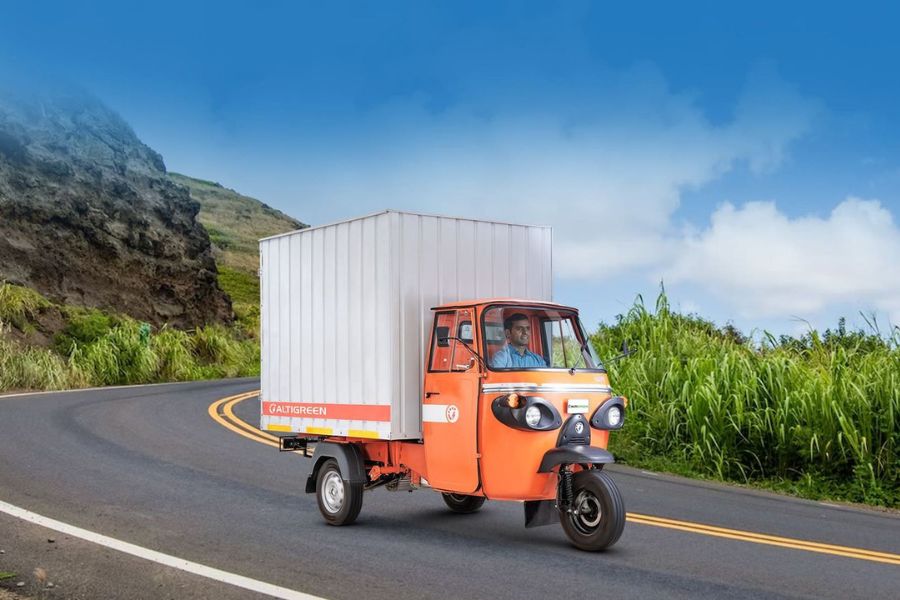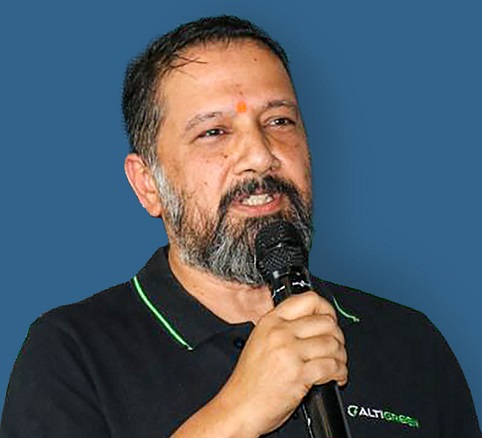Our focus is to craft EVs using components “Made in India”
India’s electric vehicle (EV) manufacturing landscape has undergone significant growth and transformation in recent years. Fueled by government initiatives, technological advancements, and a growing environmental consciousness. As India strives to reduce emissions and enhance energy security, the EV manufacturing landscape is emerging as a pivotal force in shaping the future of transportation and sustainable mobility in the nation.
Altigreen stands at the forefront of EV technology and last-mile transportation solutions with electric vehicles meticulously crafted with Indian conditions in focus, addressing both environmental and commercial requirements.
In an exclusive conversation with India Business & Trade, Amitabh Saran, CEO of Altigreen, shares his inspiring journey towards producing electric vehicles suited for the challenging terrains of India. He also delves into the essential technological strides needed to realize India’s ambitious sustainability objectives.

Image Credit: Altigreen
IBT: What inspired the establishment of your company and how did that initial inspiration drive its journey? Could you highlight a few key milestones that your company has achieved along the way?
Amitabh Saran: The journey of Altigreen commenced nearly a decade ago, driven primarily by the significant loss of lives in India each year due to the adverse air quality resulting from road transportation. It’s astonishing to realize that this toll ranges from five to six hundred thousand individuals annually. This figure is alarmingly high when compared to the mortality caused by Covid. Our country witnesses the loss of five to six lakh lives every year due to pollution associated with road transportation. Urgent action is imperative, and the responsibility to instigate this change often falls upon those capable of bringing about transformative shifts – startups. Startups are the driving force behind change, and they are at the forefront of these endeavours.
AltiGreen’s inception was prompted by identifying a gap in India’s electric vehicle landscape: the absence of advanced drivetrain technology necessary for creating competitive electric vehicles. Recognizing that robust drivetrain systems were pivotal for developing EVs capable of rivalling fossil fuel counterparts, the company initiated its journey in this direction. With a current portfolio of 29 global patents, Altigreen handles the entire EV component lifecycle — design, development, fabrication, and manufacturing. This includes motors, controllers, converters, harnesses, gearboxes, battery management systems, and battery packs. Through a collaborative partner ecosystem, Altigreen’s comprehensive involvement ensures a holistic design approach.
Specializing in two-wheelers, three-wheelers, and small commercial four-wheelers, Altigreen strategically targets the three-wheeler market as its initial focus. The rationale is compelling: around 400 million individuals, equivalent to 40 crore people, use or encounter a three-wheeler daily in India. By concentrating on such a sizable market segment, Altigreen leverages the potential to drive substantial change. This deliberate choice underscores the company’s commitment to making a profound impact and is indicative of its dedication to pioneering advancements in sustainable transportation.
IBT: Your vehicles are specifically designed to cater to Indian conditions, both environmental and commercial. Could you share some insights into the unique challenges and opportunities that Altigreen considers when developing EVs for the Indian market?
Amitabh Saran: When envisioning electric vehicles, many picture open highways and fast cars on unoccupied roads. However, our geographical reality differs significantly. Amidst heterogeneous traffic, road congestion, potholes, and unprofessional driving, we must acknowledge our unique challenges. Our roads often witness scenarios considered abusive elsewhere: dust, overloading, pebbles. Accepting this reality is crucial. Additionally, we must recognize the success of fossil fuels over the past century. These fuels have powered vehicles that met our needs during India’s developmental stages, and despite acknowledging their positive impact, we must embrace the shift towards electric mobility.
When venturing to replace established technology with something innovative and futuristic—like our focus on electric mobility—it’s imperative that the new solution isn’t just different but capable of competing and excelling compared to the existing technology. It must surpass the status quo; compromise is not an option. Historically, electric vehicles (EVs) in India have often been characterized by compromises—imposed limitations on speed, air conditioning use, and other constraints. Such compromises have hindered EVs from competing effectively on both price and performance with traditional fossil fuel-powered vehicles. Recognizing this, AltiGreen was resolute from the outset: Our electric solutions had to outperform fossil fuel options, ensuring a compelling reason for people to embrace and adopt them.
For us, this meant rigorous testing and meticulous design. We subject our vehicles to stringent tests, including shocks and vibrations, in order to ensure their durability and resilience. The components undergo meticulous testing to ensure they meet our high standards. The manufacturability and supportability of these components are of paramount importance, particularly considering India’s resourceful mindset where items are often repaired and maintained instead of being discarded. Thus, we take into account these factors when designing our components to guarantee that the resulting electric vehicles outshine their fossil fuel counterparts.
It’s essential that this pursuit of excellence doesn’t come at a prohibitively high cost. Our aim is to develop these components and vehicles with a cost structure that’s on par with existing technologies. Despite the challenges inherent in this endeavour, we remain committed to our goal.
AltiGreen’s mission is to transcend compromises that have limited the potential of electric vehicles in India. We’re dedicated to designing components and vehicles that are not only environmentally friendly but also superior to fossil fuel alternatives. Through stringent testing, thoughtful design, and a commitment to cost-effectiveness, we’re working to shape a future where electric vehicles are the preferred choice, not due to compromise, but because they offer undeniable advantages.
IBT: What are Altigreen’s strategies for minimizing the environmental footprint throughout the lifecycle of your mobility platforms, from manufacturing to usage and disposal?
Amitabh Saran: So, as you may know, we established our company back in 2012-2013. We were very clear from the outset that our goal was to manufacture everything within India, using components largely available in the country. I’m pleased to share that we don’t import magnets or any other unnecessary components. This approach ensures that we maintain the production of high-quality vehicles in our nation. The domestic value addition within our system is exceptionally high, primarily due to our in-house production of these components. Our material selection for components is carefully considered; we prioritize materials readily available within our country. Yet, we’re proud to produce vehicles that are not only equivalent but often surpass the performance of fossil fuel counterparts currently available
In terms of reuse and recycling, we primarily employ aluminium, steel, and copper—materials that are fully recyclable. However, our main focus lies in addressing the recyclability of battery packs and lithium-ion cells. To tackle this, we’ve established strategic alliances enabling us not only to recycle batteries but also to repurpose them for second-life applications. After fulfilling their useful lifespan in vehicles, these battery packs find value in other areas, especially within the context of the burgeoning solar industry in India.
The landscape of solar energy is rapidly evolving, with distributed rooftop solar gaining prominence. Our batteries and cells have a vital role to play in this transformation. We anticipate their integration into various applications, from distributed solar setups to home UPS systems, replacing traditional lead-acid batteries. These electric vehicle batteries, built to last for decades in their original applications, can extend their utility to smaller-scale scenarios.
Beyond recycling, we’re actively exploring various applications for these lithium components, ensuring they continue to contribute even after their initial use. This forward-looking approach aligns with our commitment to sustainability and resourcefulness.
IBT: The government is planning to launch FAME 3 by next year, are there any specific recommendations or expectations that you would like to share?
Amitabh Saran: I believe that establishing subsidy regimes as the basis for discussing disruptive change isn’t a perspective I endorse. However, during the formation of an ecosystem for a novel technology, fluctuations are inevitable. Subsidies can play a crucial role in stabilizing such circumstances. This trend is observable worldwide—across different geographies, subsidies have been integral. For instance, our neighbouring country, China, has utilized subsidies for over a decade. Recently, there was a significant decline in vehicle sales when they considered removing subsidies.
This underscores the importance of continuing the FAME (Faster Adoption and Manufacturing of Hybrid and Electric Vehicles) subsidy. It’s worth noting why subsidies were introduced in the first place: the high cost of batteries rendered electric vehicles non-competitive against fossil fuel alternatives.
The cost of batteries remains notably high, which is why we implemented the strategy of linking subsidies to the per kilowatt-hour capacity of the battery pack utilized. This decision was prompted by the need for such an approach. However, has there been price parity between battery costs and fossil fuels during the last two or three years of FAME’s existence? Unfortunately, that hasn’t been the case. Despite the anticipation of decreasing prices, this convergence has not materialized.
I still believe that the government has commendably introduced the PLI (Production-Linked Incentive) scheme for batteries. Once the PLI scheme becomes effective and cell manufacturing establishes itself in India, the cost of lithium batteries is expected to decrease. It is then that the government should contemplate removing subsidies or altering the FAME framework. Until price parity is achieved, FAME’s continuation is paramount. Gradually phasing out subsidies could be considered—an approach I’m in agreement with. The introduction of PLI for numerous startups facilitates our participation in production-linked incentives, allowing a hybrid model that captures benefits from both the demand and supply sides.
The government’s efforts seem aligned with this direction. Expanding the scope of FAME beyond demand-side subsidies and involving state governments in driving change is a positive step. Several forthcoming developments seem promising and are likely to shape the next phase of this transition.”
IBT: What are the recent technological innovations or advancements that the company has introduced to enhance the performance, efficiency, and user experience of your EVs?
Amitabh Saran: Continuous innovation serves as the cornerstone of AltiGreen’s philosophy. The presence of 29 granted global patents stands as evidence of our unwavering commitment to innovation. This drive for innovation isn’t confined to a singular area; it permeates every facet of our vehicles. It extends beyond mechanical, electrical, electronics, and software domains, as it’s the synergy of these changes that propels our progress.
Increasingly, the landscape of electric vehicle innovation is shifting towards software and networking domains—areas that have often been less explored. While the focus was initially on mechanical, electrical, and electronic advancements, a notable transition towards data and software is becoming evident. AltiGreen is actively engaged in this sphere, with a unique perspective stemming not just from my role as CEO, but also my background with a PhD in computer science. The pivotal role of data and software as key differentiators in the future of electric vehicles is firmly acknowledged.
Notably, GPT engines are already integrated into our vehicle development strategy, particularly in the creation of our software stacks. This incorporation is ongoing, paralleling our shift towards Edge computing. This initiative enables swift decision-making regarding driver behaviour and vehicle performance. As we delve into efficiency enhancement, our focus aligns with the three to four per cent realm—striving to optimize the efficiency of our electronics, battery packs, and motors.”
You will be happy to know that GPT engines are already being used as part of the development strategy for our vehicles, for the software stacks that we are building.
A significant portion of a vehicle’s efficiency is compromised due to driving behaviour, which can impact efficiency by as much as 30%. Remarkably, incorrect driving behaviour takes a substantial toll on vehicle efficiency. Curiously, I haven’t encountered a single individual who has attended driving school and is subsequently driving a commercial vehicle in our country—especially not within the category I’m addressing, such as three-wheelers or small commercial four-wheelers. Typically, these drivers transition from being protégés to eventually becoming drivers without formal training.
Addressing this challenge necessitates extensive software-based interventions to enhance efficiency. In the case of internal combustion engine (ICE) vehicles, efficiency typically ranges from 20 to 24%. However, in the domain of electric vehicles, this efficiency soars to an impressive 80 to 90%.
As the effective utilization of energy becomes increasingly paramount, the role of software assumes even greater significance. Consequently, we can expect to witness a growing integration of software that extends beyond mere Advanced Driver Assistance Systems (ADAS). It encompasses features like vehicle-to-vehicle and vehicle-to-infrastructure communication. These aspects are already in the works, and we’re also leveraging GPT engines to gather extensive data, enabling real-time decision-making. This data-rich environment aids drivers in achieving greater efficiency while operating their vehicles.
Moreover, the data can be harnessed to secure favourable insurance deals for prudent drivers. Today, I can ascertain a driver’s safety not solely based on speed or driving pace, but also by analyzing countless subtle factors that define safe driving. If a driver consistently displays safe driving behaviour, could I then assist in securing them a lower insurance premium? This scenario finds its feasibility in the realm of electric vehicles, a feat that wasn’t attainable with fossil fuel alternatives. These are the avenues we’re diligently exploring—tailoring solutions based on specific use cases and driver preferences, magnifying the benefits of electrification. Beyond the commonly acknowledged attributes such as a smooth ride and environmental impact, we’re delving into how vehicle choices resonate with personal lives, emphasizing the broader positive implications for individuals.”
IBT: Looking ahead, what are Altigreen’s key priorities and ambitions in the coming years? Are there any upcoming projects, partnerships, or innovations that you are particularly excited about and would like to share?
Amitabh Saran: Innovation keeps progressing, and one certainty from the start is that electric vehicles are here to stay. The future is electric, regardless of the electricity’s source—be it lithium, sodium, aluminium, or fuel cells. The crucial point is that vehicles will be electric, and this trend will persist. Continued innovation will arise from partnerships, as it’s not feasible to achieve everything in isolation. Creating an entire ecosystem around electric vehicles is essential.
This perspective might not be immediately apparent when comparing it to fossil fuels, which have developed over the past century. Think about street-side workshops, spare parts, vehicle financing, and service infrastructure that have naturally evolved. Similarly, access to fuel is taken for granted. However, for electric vehicles, this complete framework must be established anew. This doesn’t mean we halt progress; instead, we need to prioritize areas where existing infrastructure can be effectively utilized.
That’s why we opted for three-wheelers. Understanding that they cover substantial daily distances—100 to 130 kilometers—led us to create vehicles that accommodate this requirement. In a nation where 99 percent is electrified, a power source is conveniently accessible compared to the distance one might need to travel for diesel, CNG, or LPG refueling. Although this might be more challenging in remote areas, an electricity source is generally available nearby.
The approach we’re embracing involves immediate applications that align with current infrastructure and gradually expand as additional elements, including financing and charging networks, develop. This approach resonates with AltiGreen’s strategy. We began with three-wheelers, initially cargo-focused and progressing to passengers. This progression ensures availability for both passengers and cargo, eventually moving towards four-wheelers. We are firmly committed to fulfilling the well-defined use cases for cargo and commercial vehicles, a cornerstone of our focus.
IBT: What advice would you offer to those who are looking to make a positive impact in the field of sustainable transportation and technology?
Amitabh Saran: I’m always supportive of entrepreneurs. This is my third venture. My previous two companies were acquired. It’s not simple, it’s truly tough, but it’s also incredibly rewarding. The rewards aren’t the main focus; the journey itself, with its everyday progress, is what keeps you motivated. If you have that drive within you to bring about change, embrace it. This drive will propel India forward. If you’re thinking others might already be doing it or you can’t do it alone, believe me, take action. Stand up, initiate, and create change. We need numerous individuals; there’s ample room for innovation. You just need to be dedicated and determined to make it happen. It will be a challenging journey, so patience is vital. Stay on the course you’ve set, and success will come. I’m almost certain that doing the right things will lead you to success.

A former software engineer with 32 years of business experience, Amitabh Saran changed gears to realize his dream of making India an EV superpower. He has, in the past, been the co-founder of tech start-ups that include TriVium and Buzzintown and has worked with leading MNCs including TCS, Philips, NASA and HP. He holds a Ph.D. in Computer Science from UC Santa Barbara and has written extensively on EVs along with numerous technical papers.













Nice article on localisation of parts for the ev.
Would you be interested in presenting a technical paper on the use of aluminium in electric vehicles especially the structural parts at the technical conference of Alucast at Baroda on 24-25 Nov 2023